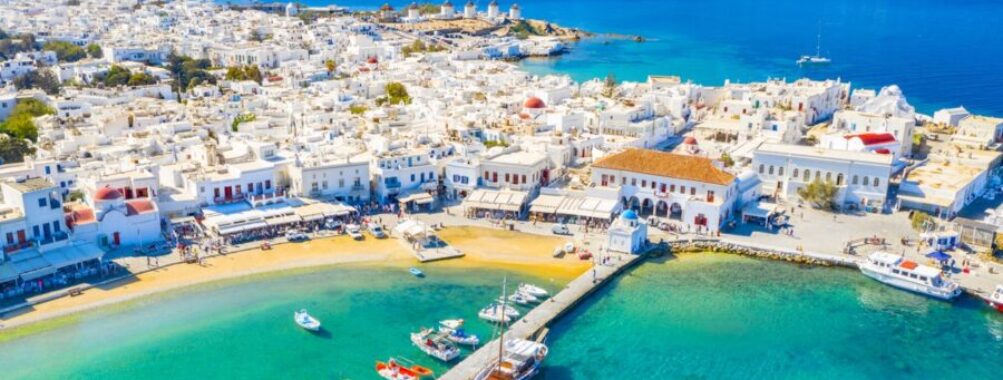
7 Days in Crete, Santorini & Mykonos Itinerary: Ultimate Greek Island Adventure
Planning a week in Greece can feel overwhelming with so many islands calling your name, but you don’t need to stress. A 7-day itinerary through Crete, Santorini, and Mykonos gives you the perfect balance of history, beaches, and island culture without wasting time figuring it out on the fly. You’ll cover the highlights, see the iconic spots, and still have space to slow down and enjoy the small moments.
I’ve spent years hopping between these islands, and every time I return, I notice something new—like a tucked-away café in Mykonos Town or a quiet stretch of Cretan coast most tourists never find. You’ll get the big sights, yes, but also those little experiences that make a trip feel personal.
Table of Contents
- Key Takeaways
- Essential Trip Planning for 7 Days in Crete, Santorini & Mykonos
- Best Time to Visit the Greek Islands
- How to Get Around: Ferries, Flights, and Transfers
- Packing Tips for Island-Hopping
- Budgeting and Travel Costs
- Day 1: Athens Gateway – Ancient Wonders and Modern Life
- Exploring the Acropolis and Parthenon
- Strolling Through Plaka and Monastiraki Square
- Must-See Museums and Archaeological Sites
- Days 2-3: Santorini – Caldera Views, Villages & Volcanic Beaches
- Oia and Fira: Iconic Villages and Sunsets
- Santorini’s Black Sand Beaches and Caldera Activities
- Local Cuisine and Unique Wine Experiences
- Days 4-5: Mykonos – Chic Towns, Beaches & Island Excursions
- Mykonos Town (Chora) and the Mykonos Windmills
- Little Venice and Vibrant Nightlife
- Top Beaches: Paradise, Psarou, and Paraga
- Day 5: Delos Island – Myth, History & UNESCO Heritage
- Exploring the Sanctuary of Apollo
- Terrace of the Lions and Ancient Ruins
- Days 6-7: Crete – Minoan Legends, Beaches & Cretan Culture
- Palace of Knossos and the Minotaur Myth
- Chania Old Town and Venetian Harbor
- Elafonissi Beach: Pink Sand and Turquoise Water
- Hiking Samaria Gorge and Outdoor Adventures
- Frequently Asked Questions
- What are the must-visit attractions for a 7-day island-hopping itinerary in Greece?
- How can one optimize their travel schedule to include Athens, Mykonos, and Santorini in a 7-day trip?
- What is the recommended amount of time to spend in Mykonos and Santorini during a week-long vacation?
- What are some hidden gems in Crete, Santorini, and Mykonos that should not be missed?
- How should travelers distribute their time between Athens, Crete, Mykonos, and Santorini for an immersive experience?
- Book Your Dream Experience
- More Travel Guides
Key Takeaways
- A 7-day plan balances history, beaches, and culture across three islands
- You’ll see iconic highlights while still having time to relax
- Local insights help you avoid common tourist pitfalls
Essential Trip Planning for 7 Days in Crete, Santorini & Mykonos
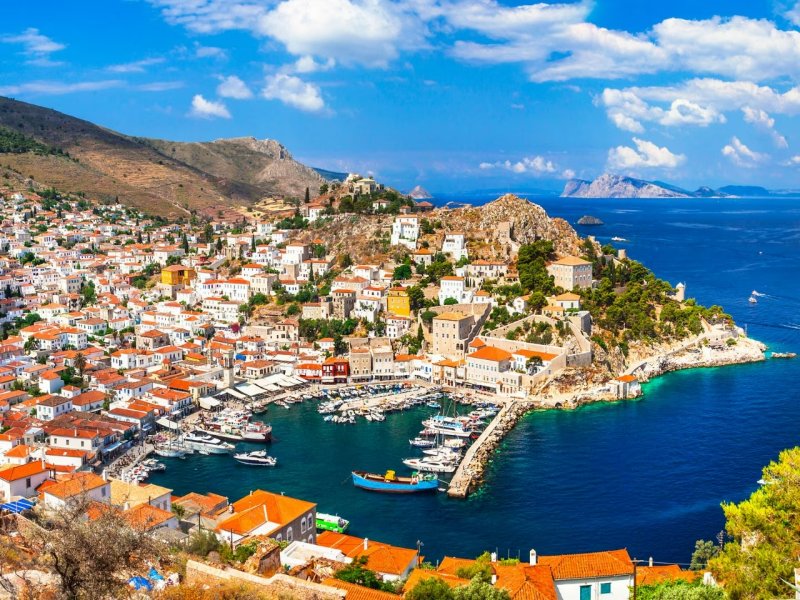
Island-hopping in Greece means juggling ferries, flights, and hotel check-ins while also making sure you’ve packed right for the Mediterranean sun and occasional wind. Costs can add up quickly, but with a bit of planning you’ll stretch your budget without cutting corners on the experience.
Best Time to Visit the Greek Islands
Late spring (May–early June) and early fall (September–October) are the sweet spots. The weather is warm but not scorching, the sea is swimmable, and the crowds are thinner than July and August.
In peak summer, ferries and hotels sell out fast, and prices jump. If you want that postcard-perfect Santorini sunset without elbow-to-elbow crowds, avoid mid-August when half of Europe seems to be on holiday.
Winter is very quiet. Some ferries cut back, beach clubs close, and nightlife is limited. If you’re more into history and food than beaches, you’ll find lower hotel rates and a slower pace.
How to Get Around: Ferries, Flights, and Transfers
The classic way to travel between Crete, Santorini, and Mykonos is by ferry. Most routes leave from Athens’ Piraeus port, the country’s busiest harbor. High-speed ferries are faster but pricier, while conventional ferries are cheaper and more relaxed.
Flights can save time, especially from Athens to Crete. Santorini and Mykonos also have small airports, so you can hop on short domestic flights if you’re pressed for time.
On the islands themselves, taxis are limited and expensive. Renting a car in Crete is almost a must since the island is huge. In Santorini and Mykonos, ATVs and scooters are popular, but buses connect most tourist areas too.
Packing Tips for Island-Hopping
You’ll move around a lot, so pack light. A carry-on sized suitcase or backpack makes ferry boarding much less stressful. Wheels are handy, but remember some towns like Oia in Santorini have steep steps and cobblestones.
Bring layers. Evenings can get breezy, especially on Mykonos. A light jacket or sweater will save you from shivering through dinner.
Don’t forget practical items: a reusable water bottle, power adapter, and comfortable walking shoes. I always recommend a small dry bag for boat trips. If you need to upgrade your travel gear, browsing travel gear options online saves time before you fly out.
Budgeting and Travel Costs
A 7 day Greece itinerary across these islands can be done on different budgets, but expect higher prices in Santorini and Mykonos. Crete is usually more affordable, especially for food and accommodation.
Hotels range from budget hostels to luxury cliffside suites. You can compare rates easily on Booking.com and decide what fits your style.
Ferries average €40–€70 per trip, while flights can be similar if booked early on sites like KAYAK. Meals at tavernas are reasonable, but beach clubs and trendy restaurants in Mykonos will eat into your budget quickly.
If you plan ahead, you can balance splurges with savings—like enjoying street gyros one night and a sunset dinner the next.
Day 1: Athens Gateway – Ancient Wonders and Modern Life
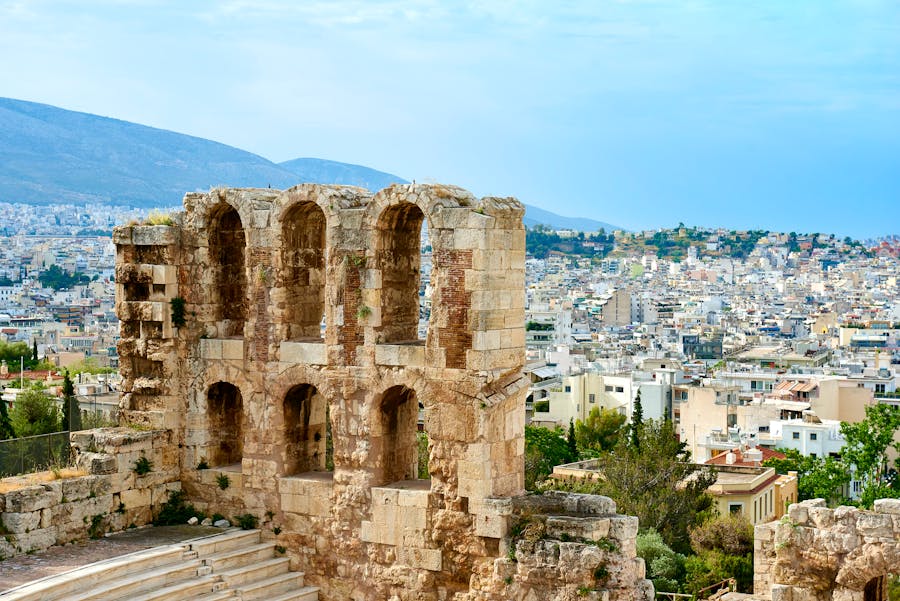
Your first day in Greece begins in Athens, where ancient ruins sit right beside buzzing neighborhoods and lively squares. You’ll spend the day walking through sites that shaped Western history, while also dipping into modern cafes and street markets that show the city’s daily rhythm.
Exploring the Acropolis and Parthenon
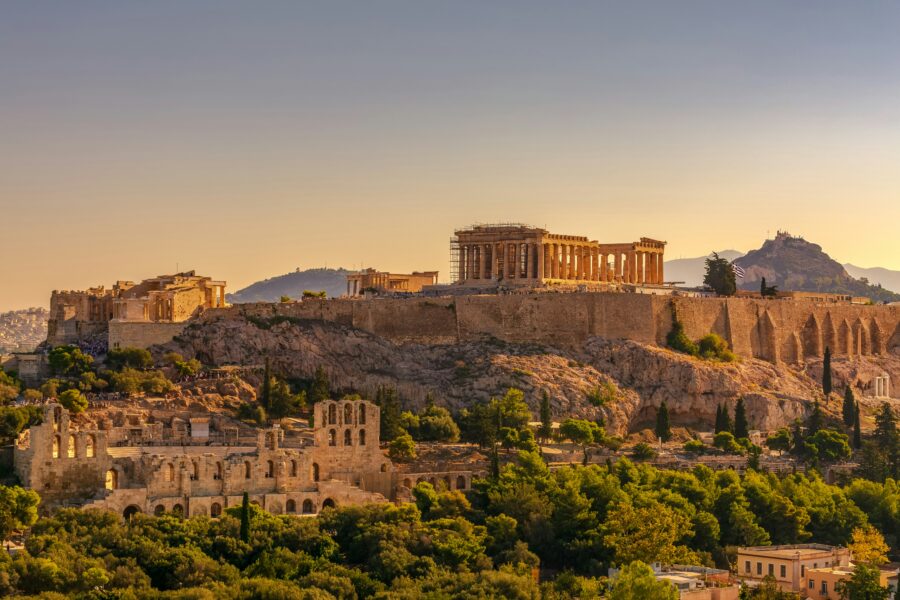
Start early at the Acropolis, before the midday sun and tour groups arrive. The climb isn’t long, but the marble steps can be slippery, so good shoes help. At the top, the Parthenon dominates the skyline. Even half-ruined, it’s an incredible sight—columns rising against the blue sky.
Don’t skip the Temple of Athena Nike, small but elegant, perched on the edge of the hill. From here, the view stretches across Athens all the way to the sea.
On your way down, pause at the Odeon of Herodes Atticus, still used for concerts in summer. It’s a reminder that these ruins aren’t just relics—they’re still part of the city’s life. I once caught a rehearsal echoing through the stone seats, and it gave me goosebumps.
Bring water, sunscreen, and patience—this is the most popular site in Greece, and for good reason.
Strolling Through Plaka and Monastiraki Square
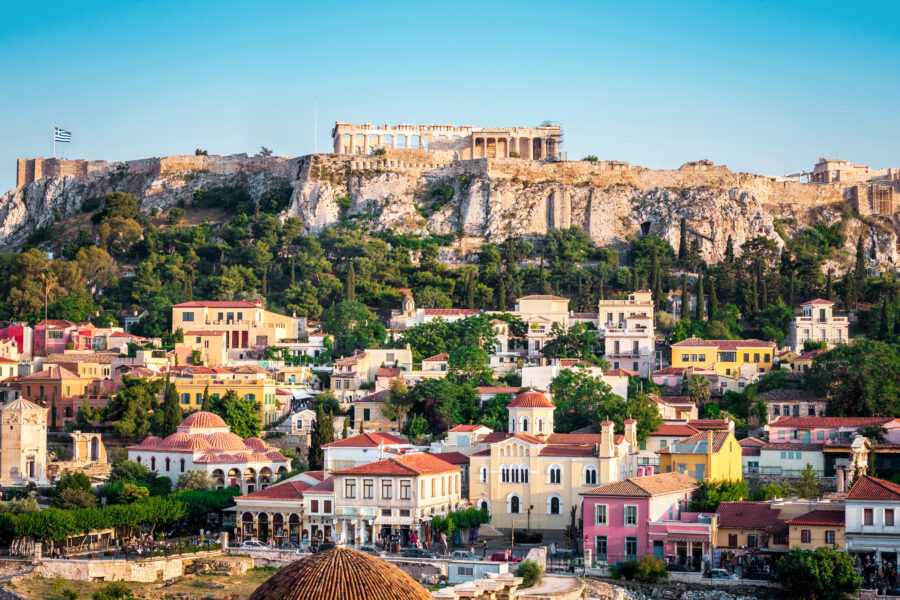
After the Acropolis, head into Plaka, the old quarter. Its narrow streets twist past neoclassical houses, tavernas with outdoor tables, and little shops selling everything from handmade sandals to Byzantine icons. If you’re hungry, order souvlaki or a plate of moussaka at a family-run spot tucked into a side alley.
A short walk brings you to Monastiraki Square, one of the liveliest corners of Athens. Street vendors sell jewelry, leather goods, and antiques, while the call to prayer from the Tzistarakis Mosque mixes with the buzz of cafes.
Nearby, you’ll find Hadrian’s Library, built by the Roman emperor, and the Ancient Agora, once the political and commercial heart of the city. The Temple of Hephaestus inside the Agora is one of the best-preserved temples in Greece.
If you’ve got energy left, wander toward Syntagma Square to see the Greek Parliament and the changing of the guard. It’s a short walk but adds another layer of history to your day.
Must-See Museums and Archaeological Sites
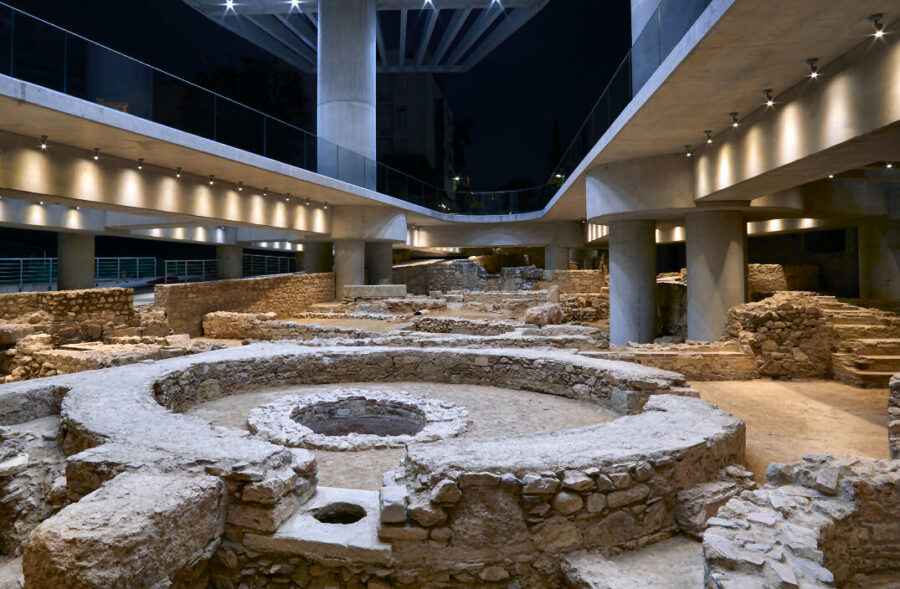
Athens has more museums than you can fit in one trip, but a couple stand out. The Acropolis Museum sits at the base of the hill and houses original sculptures from the Parthenon and other temples. The glass floors reveal excavated ruins beneath your feet, which is a detail I always found fascinating.
The National Archaeological Museum is a bit farther out, but it’s worth the taxi ride. Here you’ll see treasures like the Antikythera Mechanism, often called the world’s first computer. It’s a complex device of gears pulled from a shipwreck, and it still baffles scientists today.
Other smaller sites are scattered around the city. The Temple of Olympian Zeus is a short walk from Syntagma, though only a few columns remain. For a sweeping view of the whole city, consider a late afternoon climb (or funicular ride) up Mount Lycabettus. Watching the sun dip over Athens from there is a memory that sticks with you long after you leave.
Days 2-3: Santorini – Caldera Views, Villages & Volcanic Beaches
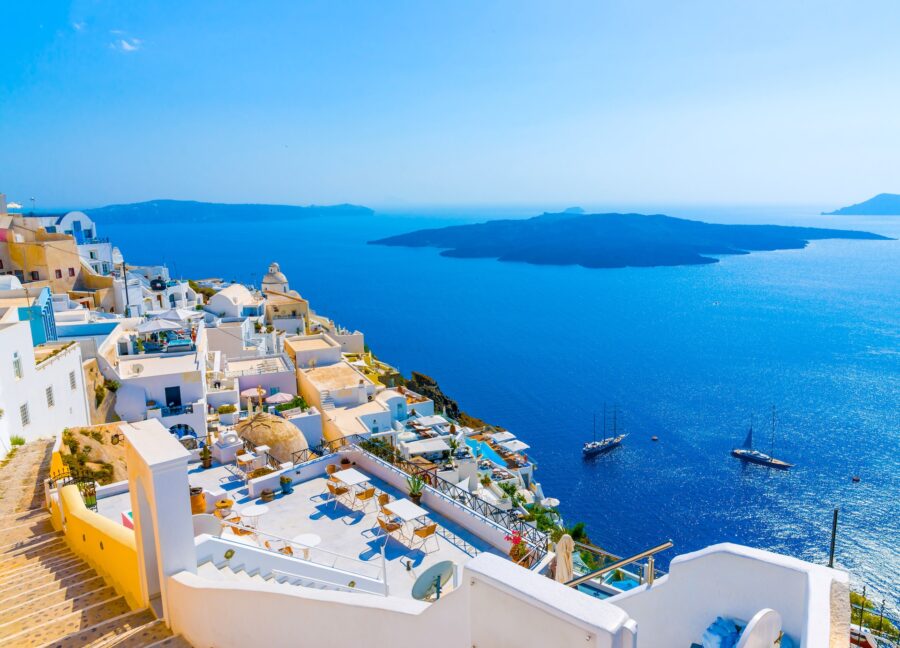
Santorini rewards you with iconic cliffside villages, dramatic volcanic scenery, and beaches unlike anywhere else in the Greek islands. You’ll balance time between exploring whitewashed lanes, relaxing by the Aegean, and tasting flavors you won’t easily forget.
Oia and Fira: Iconic Villages and Sunsets
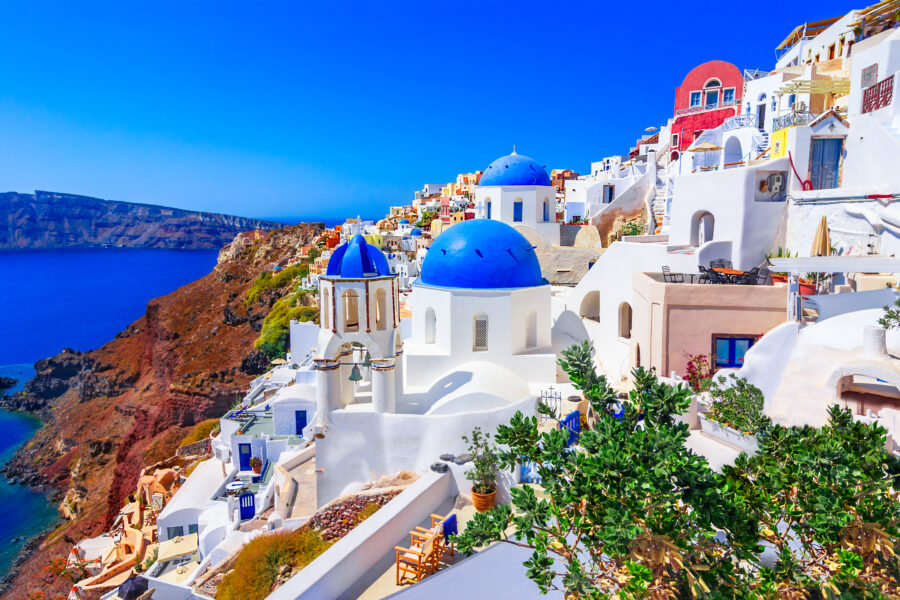
Oia and Fira are the two villages you’ll probably picture when you think of Santorini. Both sit on the caldera edge with sweeping views of the Mediterranean. Oia is quieter during the day, with narrow alleys, small art shops, and the famous blue-domed churches.
In the evening, Oia becomes the island’s busiest spot. Crowds gather around the castle ruins for sunset, but honestly, it can feel overwhelming. A better option is to book a table at a small restaurant with a terrace view—less pushing and shoving, more wine in hand.
Fira, the capital, has a livelier feel. You’ll find more nightlife, shopping, and museums here. The hike between Fira and Oia is one of the best walks in the Greek islands, about 10 km along the cliffs. Start early in the morning to avoid the heat and you’ll have the trail mostly to yourself.
Santorini’s Black Sand Beaches and Caldera Activities
Unlike Mykonos or Crete, Santorini’s beaches are volcanic, so don’t expect soft white sand. Instead, you’ll find dramatic black sand beaches like Perissa and Kamari. Bring sandals because the sand gets scorching under the midday sun. Beach clubs line the shore with umbrellas, loungers, and plenty of cold frappés.
If you want something more active, the caldera offers boat trips to the volcano and hot springs. You can even book organized day tours that combine swimming, hiking the volcanic crater, and sunset cruising. These trips give you a totally different perspective of the island—you’re looking up at the cliffs instead of down from them.
Red Beach near Akrotiri is another unique stop, with striking red cliffs dropping into the sea. It’s small and gets crowded, but worth a quick swim if you’re in the area visiting the archaeological site.
Local Cuisine and Unique Wine Experiences
Santorini’s volcanic soil gives its food and wine a unique edge. Tomatoes here taste noticeably sweeter, and the local fava (yellow split pea puree) is somehow creamier than what you’ll find elsewhere in Greece. Don’t miss tomato fritters, white eggplant, and the freshest seafood you’ll ever eat—especially if you grab a table right by the water in Amoudi Bay.
The island’s wines, especially Assyrtiko, are a real point of pride. Vineyards use this wild basket-shaped growing method that shields grapes from the wind. Some wineries, like Venetsanos, offer tastings with jaw-dropping caldera views; others, like Gavalas, keep things more low-key and personal.
If wine’s not your thing, the food scene still shines. Even the simplest tavernas turn out meals that taste homemade. And please, don’t skip dessert—baklava with local honey is practically made for a late-night stroll through the villages.
Days 4-5: Mykonos – Chic Towns, Beaches & Island Excursions
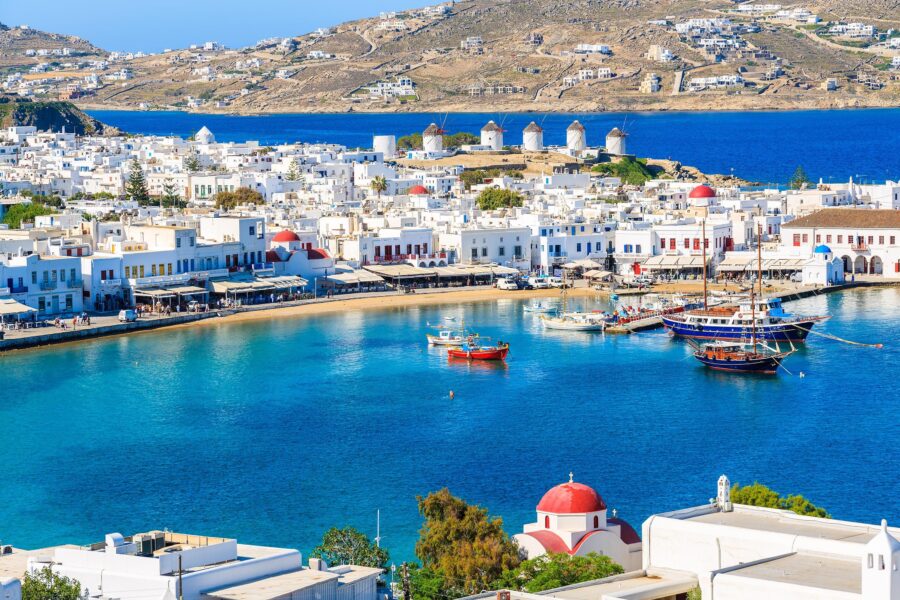
Mykonos is where whitewashed villages, famous landmarks, and some of the Aegean’s best beaches all come together. You’ll find yourself wandering twisty alleys, catching sunsets over the water, and relaxing on beaches that range from peaceful to packed with energy depending on your mood.
Mykonos Town (Chora) and the Mykonos Windmills
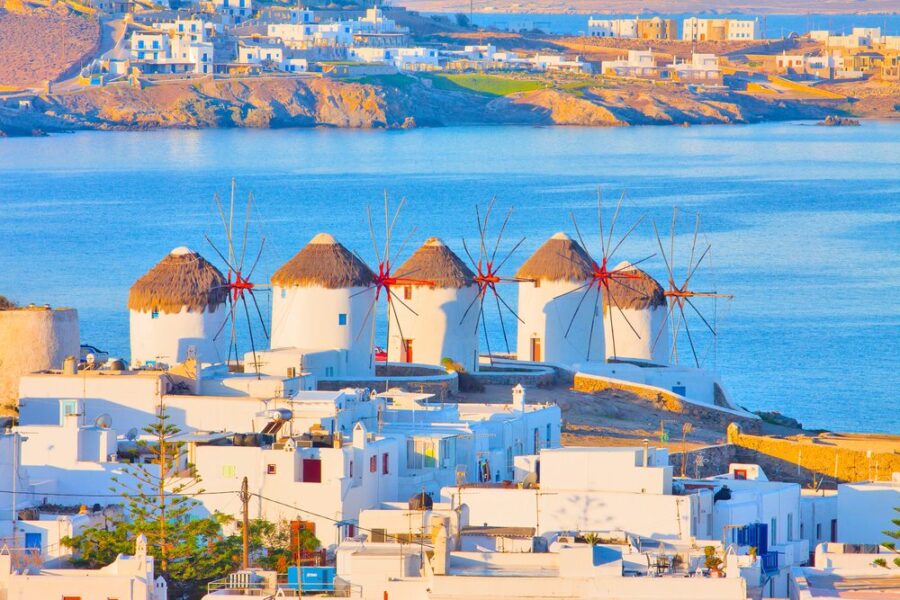
Start off in Mykonos Town (Chora), the island’s lively center. The maze of streets was built to confuse pirates, but now it’s just full of boutiques, bakeries, and tucked-away courtyards. Getting lost is almost the point.
The iconic Mykonos windmills sit on the hill above town—no longer spinning, but still one of the best photo ops around. I’d go in the late afternoon, when the light is soft and the crowds thin out a bit.
If you want more than just wandering, try a walking tour or a small-group excursion you can book ahead of time. It adds some context to all those whitewashed walls and saves you from aimless wandering (unless that’s your thing).
Little Venice and Vibrant Nightlife

Just a quick stroll from the windmills, Little Venice is probably the prettiest slice of the island. The houses are built right on the water, with wooden balconies that nearly dangle over the sea. It’s the perfect place to linger over a drink while the waves crash below.
At sunset, the area buzzes with people. The view of the sun sinking into the Aegean is what everyone’s after, and yeah, it’s worth squeezing in. For something quieter, find a table in the back alleys, then wander down to the water once the sky starts to glow.
When night falls, Mykonos shifts gears completely. Chora’s bars run the gamut from tiny cocktail spots to full-on dance clubs. Even if clubbing isn’t your thing, it’s fun to pop into a couple of places just to soak up the scene. The island feels totally different after dark.
Top Beaches: Paradise, Psarou, and Paraga

Each beach here has its own vibe. Paradise Beach is the go-to for daytime parties and beach clubs that don’t really quit. If you want music and dancing, this is your spot.
For a more upscale scene, check out Psarou Beach. It draws a jet-set crowd, with fancy loungers and high-end restaurants. The water’s calm and clear—great for a swim if you snag a spot early enough.
Paraga Beach lands somewhere in the middle. You’ll find lively tavernas but also quiet corners to chill. I like Paraga because you can pick your mood—grab a sunbed with music or wander down the shore for a peaceful swim.
If you’re short on time, beach hopping is easy here since most are close together. Renting a scooter or ATV makes bouncing between them a breeze.
Day 5: Delos Island – Myth, History & UNESCO Heritage
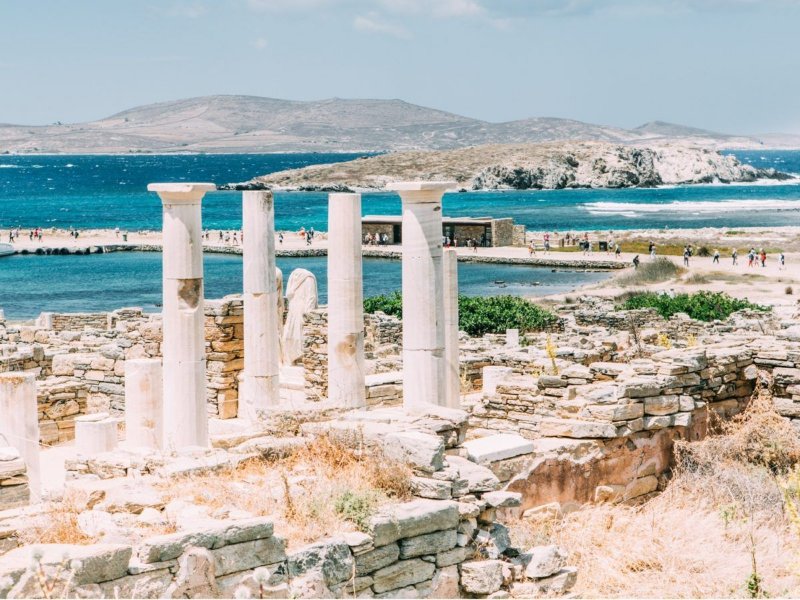
Just a quick boat ride from Mykonos, Delos packs a huge punch for such a tiny island. It’s a UNESCO World Heritage Site loaded with sacred temples, dramatic ruins, and some of the most important archaeological finds in the Aegean.
Exploring the Sanctuary of Apollo

Your first stop is usually the Temple of Apollo, Delos’s ancient heart. Pilgrims from all over Greece once came here to honor Apollo, god of light, music, and prophecy. Even in ruins, the place has a weird sort of power. The huge stone foundations and scattered columns show just how much devotion went into building it.
Wander the ancient agora and you can almost picture merchants setting up shop while travelers made offerings to the gods. Delos wasn’t just a holy site; it was a bustling crossroads where religion and commerce mixed.
Standing there on a hot afternoon, looking out at the (now dry) Sacred Lake where Apollo and Artemis were said to be born—it’s one of those rare places where myth and archaeology collide, and you can feel the layers of history pressing in.
Terrace of the Lions and Ancient Ruins
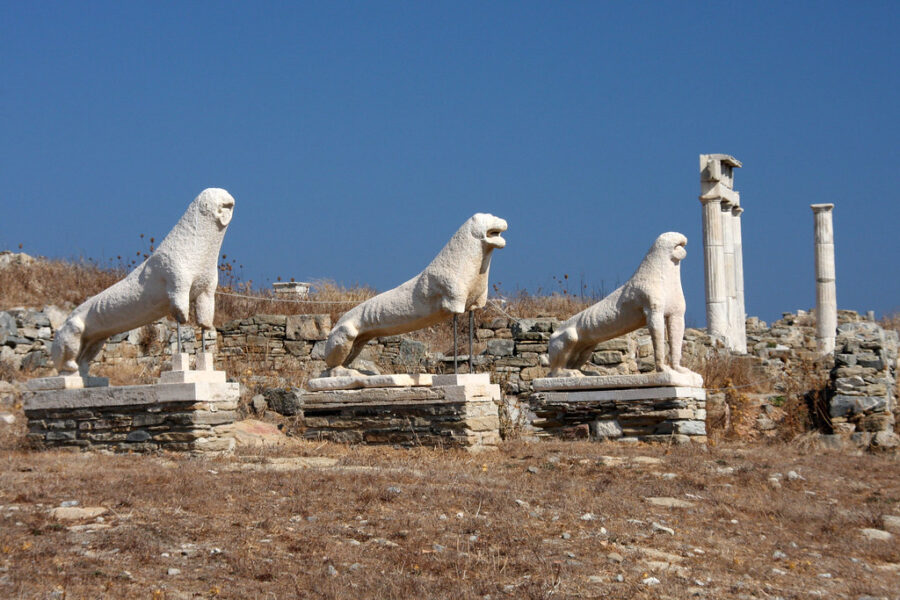
A short walk uphill leads to the Terrace of the Lions, easily the island’s most photographed spot. These marble lions, carved in the 7th century BCE, face east toward the Sacred Lake. Most are weathered or replicas (the originals are in the museum), but they still look fierce and protective.
The lions symbolized protection for the sanctuary and Apollo himself. It’s not hard to imagine the awe ancient visitors felt seeing them lined up in the sunlight.
Beyond the lions, you’ll stumble across houses with mosaics, old theaters, and shrines. The House of the Dolphins is a favorite—its floor still shows off detailed sea-life mosaics. If you rush, you’ll miss these little details, but slow down and the stories start to pile up. Delos doesn’t just tell one story; it tells dozens.
Delos isn’t just myth. The island holds traces of civilizations from the 3rd millennium BCE through early Christian times, according to the UNESCO World Heritage Centre. Walking through its ruins, you really do feel like you’re flipping through centuries of history in a single afternoon.
Days 6-7: Crete – Minoan Legends, Beaches & Cretan Culture

Crete is a wild mix of ancient ruins, rugged landscapes, and coastal villages. You’ll find stories of gods, Venetian echoes, pink sand beaches, and mountain roads that feel a world away from the crowds.
Palace of Knossos and the Minotaur Myth
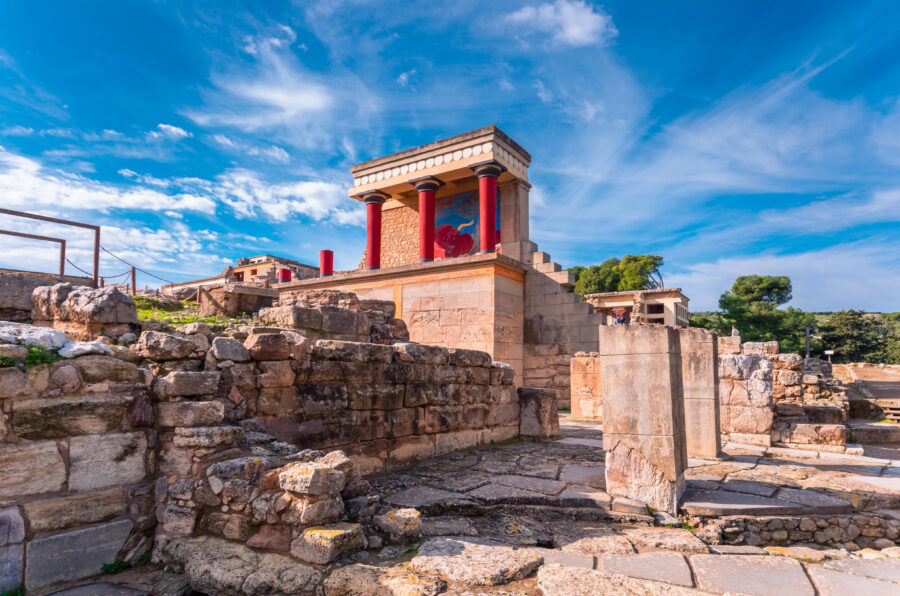
If you see only one archaeological site in Crete, let it be the Palace of Knossos. This sprawling spot near Heraklion ties directly to the legend of the Minotaur, the half-man, half-bull monster supposedly lurking in a labyrinth under the palace.
As you walk the ruins, you’ll spot restored frescoes, big staircases, and the remains of storerooms that once held olive oil and grain. The place feels more like a small city than a palace, with its layers and courtyards.
Go early if you can—before the tour buses hit. If you’re lugging bags after checkout, there’s a luggage storage nearby so you can explore hands-free. Pair it with the Heraklion Archaeological Museum, which has a bunch of original finds from Knossos.
Chania Old Town and Venetian Harbor

Chania is the kind of place you just want to wander. The Old Town is a tangle of alleys lined with pastel houses, cozy tavernas, and shops selling everything from leather sandals to Cretan knives.
The Venetian Harbor is the city’s heart. The lighthouse—built by Venetians, tweaked by Egyptians—is one of the most photographed spots on the island. Grab a Greek coffee at a waterfront café and watch the boats drift by.
If you’re into history, pop into the old mosque turned gallery or stroll through the Jewish quarter. Chania wears its mix of Venetian, Ottoman, and Greek history right on its sleeve, in both its buildings and its food.
Elafonissi Beach: Pink Sand and Turquoise Water
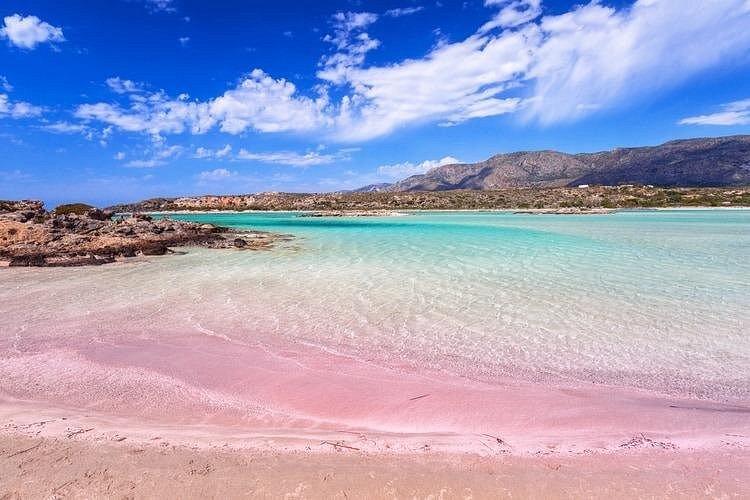
Elafonissi Beach is a stunner. The sand glows pink from crushed shells, and the lagoon is a shock of turquoise. It’s about 90 minutes from Chania, winding through mountain gorges until the coast opens up wide and flat.
The water stays shallow for ages—great for families or anyone who just wants to float. You can even wade out to a little islet that feels almost untouched.
Arrive early if you want to beat the crowds, especially in summer. There are sunbeds and umbrellas for rent, plus a couple of snack stands, but I’d still pack water and fruit. I’ve lost whole afternoons here just floating—no regrets.
Hiking Samaria Gorge and Outdoor Adventures
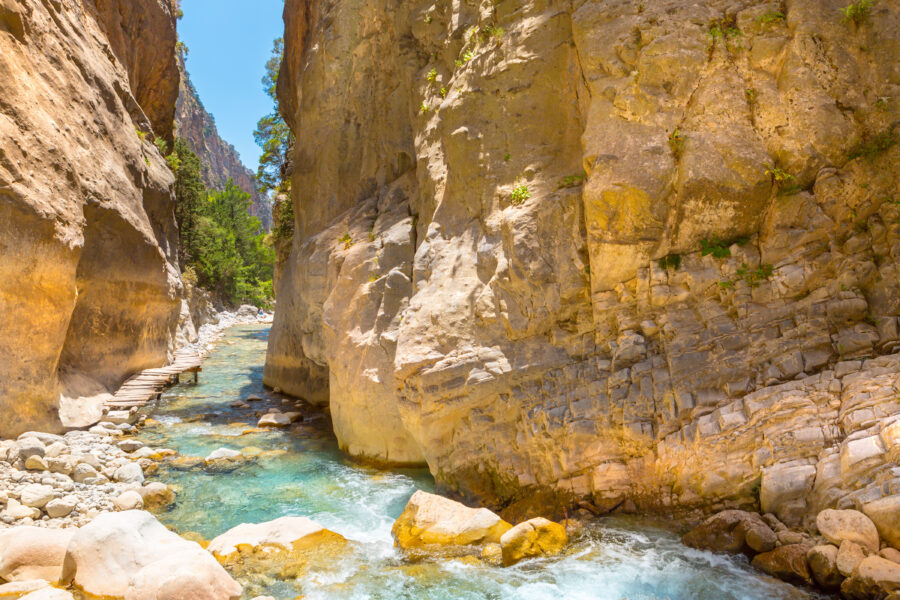
If you’re feeling active, the Samaria Gorge hike is unforgettable. The trail runs about 16 kilometers through towering cliffs, pine forests, and a dramatic pinch point called the “Iron Gates” where the walls close in tight.
The hike starts in the White Mountains and drops you at the Libyan Sea in Agia Roumeli. The only way out? By boat. That’s part of the fun.
It’s a long trek—good shoes and snacks are a must. Start early. Not a hiker? There are easier walks in smaller gorges, or just drive up into the mountain villages where life slows down and the food tastes garden-fresh.
Frequently Asked Questions
Planning a Greece itinerary that covers Crete, Santorini, and Mykonos can feel like a lot—so many choices, not enough time. Figuring out how long to spend on each island, the best ways to get around, and what to prioritize will help you make the most of a week-long trip.
What are the must-visit attractions for a 7-day island-hopping itinerary in Greece?
In Crete, don’t miss Knossos Palace near Heraklion, the Venetian harbor in Chania, and Elafonissi Beach’s pink sands.
For Santorini, check out the cliffside towns of Oia and Fira, hike between them, and try a sunset dinner with a caldera view.
In Mykonos, wander Little Venice, see the windmills, and hit beaches like Psarou or Platis Gialos. If you’re into ancient history, make time for a day trip to Delos Island.
How can one optimize their travel schedule to include Athens, Mykonos, and Santorini in a 7-day trip?
If you want to include Athens, set aside at least a full day—there’s just too much history to rush through the Acropolis, Ancient Agora, and Plaka.
Flying between Athens and the islands usually saves a ton of time compared to ferries. Most flights take less than an hour, while ferries can drag on for 4–5 hours. If you book early, you’ll probably snag better prices. Sites like cheap tickets can really help with that.
What is the recommended amount of time to spend in Mykonos and Santorini during a week-long vacation?
For a balanced Greece island hopping itinerary, try spending about 3 nights in Santorini and 2 nights in Mykonos.
Santorini’s packed with things to see—caldera towns, archaeological sites, boat tours. Mykonos is more about nightlife, beaches, and just taking it easy. This split gives you a bit of both worlds: some culture, some downtime. Isn’t that what vacations are for?
In Crete, if you’re into nature, hike Samaria Gorge. Or maybe head to smaller villages like Archanes for proper home-cooked food and local wine.
In Santorini, skip the crowded Oia sunset at least once and try Firostefani or Pyrgos instead. You’ll get those iconic views but with way fewer people breathing down your neck.
In Mykonos, wander over to Ano Mera. It’s a quiet inland village with a historic monastery—pretty much the opposite of the party scene.
How should travelers distribute their time between Athens, Crete, Mykonos, and Santorini for an immersive experience?
With just 7 days, you’ll have to make some tough choices. Lots of folks end up spending 2 days in Crete, 3 in Santorini, and 2 in Mykonos.
If Athens is a must for you, you might want to cut Crete down to a single day and give that extra day to the capital. That way, you can check out the Acropolis and wander around the city center, then still have time for the islands.
Crete really deserves more, honestly, but even a quick visit—one or two days—gives you a sense of its history and some gorgeous scenery before you hop over to Santorini and Mykonos.



